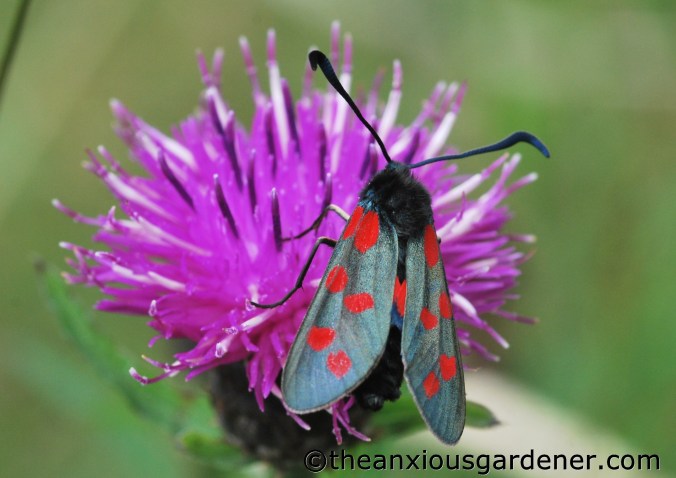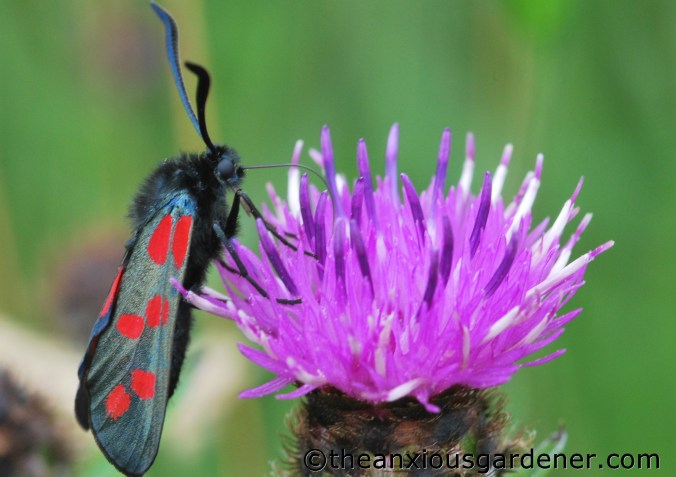Common knapweed (Centaurea nigra) grows widely in the meadow.
It flowers from June till September,
is very popular with a wide range of insects and is usually abuzz with visitors.
There are, of course, the usual bees and flies that feed on its nectar. But the other day there were three visitors that I didn’t know. So, on getting home, I dug out my ‘Boys Big Bumper Book of Bugs.’ Turns out that they were all fairly common and widespread – at least in southern England. Doesn’t make them any less beautiful though. Or welcome.
First up was a large skipper butterfly. There certainly aren’t as many butterflies at the Priory this year – at least not yet. But there are some meadow browns and skippers. So that’s good, isn’t it?
I was very taken with my second unknown; the thick-legged flower beetle. Not the most gracious of names but a rather handsome chap. And it is a chap – females don’t have the fat legs. Thin-legged flower beetles?
And then I spotted a spotty moth.
“Must be terribly rare,” I thought, as I don’t remember ever seeing one before. But no. The six-spot burnet moth is the commonest of Britain’s day-flying burnet moths. Apparently.
Might have called it the twelve-spot burnet moth, myself.
Nothing wrong with being commonplace, I suppose. We can’t all be special. Or rare.
I’m pleased that having stopped cutting the lawn-that-is-now-the-meadow, we’re attracting all sorts of insects that otherwise would have flown on by; insects that I’m now seeing – and learning the names of.
Even if some of them are rather common.









The council hadn’t mowed the verge outside our house for a couple of weeks due to bad weather and a mini-meadow popped up with attendant wildlife – maybe if we didn’t keep everything so tidy we would get more butterflies etc. Love knapweed and love your mothy-thing.
LikeLike
It is amazing how ‘lawn’ changes into such a varied habitat and so quickly. D
LikeLike
We’ve noticed a lack of butterflies here in the states as well. Nobody seems to know why or what it means.
LikeLike
Can’t help you there, NHGS. Here in the UK it is down to a too wet, too cold summer (and weird Spring). I think the States is having the opposite problem, no? Hopefully somewhere, butterflies have found conditions suitable and are living the life of Riley. D
LikeLike
Yes, we are hot and dry over more than two thirds of the country and a large part of that is in one of the worst droughts in many years. I hope the butterflies are indeed vacationing somewhere-life would be much harder without them.
LikeLike
I love the spotty moth – I had a scarlett tiger moth which is also apparently quite common but I thought it was rather exotic
LikeLike
Just googled the scarlet tiger moth, Helen. And now I’m jealous. Common as well, huh? Common schmommon. Not to me it ain’t! Very exotic looking I’d say. Dave
LikeLike
Ooh I trundle off for a week and everything goes black. Very ‘Sisters of Mercy’. Though my browser seems to be a little confused by something. Probably just having an off-day.
Beautiful pics. And I haven’t knowingly seen any of those bugs, surely not for want of looking. Love the irridescence of the big-kneed flower-minstrel…
LikeLike
Yes Sara. Black is very of the now. Of the moment. Didn’t you know? ‘Sides why have colour and light when you can have black, black, black? (Might just be a phase I’m going through). The Big-Kneed Flower Minstrel is a marvellous name. Well done. Far better than fat legged, which it clearly isn’t. And if it was a she wouldn’t be at all. Tut. Might have to fire off a letter to the Daily Mail. D
LikeLike
Common is an overused word, I think, often when the book says common it is the first time in my life I’ve seen something so it is special and rare to me. The six-spot burnet moth is a case in point, I’ve never seen one before or heard it mentioned, a real beauty. Christina
LikeLike
Hi Christina, oh good. I thought maybe it was just me, living a sheltered life and simply not noticing all these terrifically common creatures buzzing about. Phew. What a relief. D
LikeLike
Dave, I think you’re making up the “Boys Big Bumper Book of Bugs.” I tried looking it up because I don’t have a book on insects, but couldn’t find it. Does it go by another name? The knapweed photos are lovely.
LikeLike
Oh GS – I am so sorry. Yes, I confess. I made up the ‘Boys Big Bumper Book of Bugs.’ Whenever I id something I tend to say (on the blog) that I’ve looked up, whatever it was, in the ‘Boys Big Bumper Book of ……’ Sorry. It just amuses me. No-one else – just me. To identify stuff, I generally just type a short description into Google – ‘Red spotted black moth’ will pick up the six-spot burnet for example. Although I also use specific websites for flowers, insects, birds etc. I also have quite a few identifying books too but sadly none actually go by the name of, let’s say, the ‘Boys Big Bumper Book of Bumblebees.’ Which, I have to say, is a gap in the market! Dave
LikeLike
Oh my… I haven’t seen a Minnie moth for ages… In fact I was a child the last time I’ve seen one. I used to call them Minnie Moths because of their red pois. Maybe they all migrated to England. You published some very very pretty macros my friend, bravo.
LikeLike
Hey Alberto, sorry for hogging all your Minnies which, incidentally, is a better name than the six-spot (twelve actually) burnet. They will always be Minnie Moths to me now. D
LikeLike
Ah, Dave, such beautiful details in those photos. Common is an attitude, not a frequency — there are no small parts, only small actors, kind of thing. I’m sure all these insects seem remarkably individualistic to the (many) others of their kind. I was hoping for a similar success in the teeny tiny space where I’ve planted native grasses and prairie flowers, but perhaps an area larger than 5′ diameter is called for. Well done, you, on that meadow.
LikeLike
Perhaps not a larger space, Stacy but a larger, more powerful lens is what you need. Think what weird and wonderful (if common) teeny tiny insects you might then find. Might just be even tinier black widows though, huh? Anyway, you have praying mantis’s and that’s just not fair. Dave
LikeLike
How funny I saw that moth for the first time yesterday. It was basking in the heat on a pavement in Peckham so I lifted it onto a honeysuckle in the adjacent garden.
LikeLike
Often the way, Sue. I’m seeing them daily now. D
LikeLike
Beautiful photographs! I love the elegant flower beetle, there is lots of knapweed growing near me, I must check it out to see if I can see any flower beetles.
LikeLike
Thanks Amelia. I’ve taken to checking the meadow more frequently now as the sun has come out at last. At long last.
LikeLike
Wow, great photos again! The Burnet moth looks gorgeous and must say I’ve never noticed them before. Knapweed is a great plant for a wildlife garden.
LikeLike
Odd that I didn’t introduce the knapweed. Just stopped mowing and there it is! D
LikeLike
Common but so beautiful, especially that 6 (or is it 12) spotted moth. Good to see them, not a good year for our flying friends.
LikeLike
No. It’s not been a good year for so much – but then these past few days, it’s been so hot I can barely stand. And the number of insects is very noticeably up. D
LikeLike
Ah…another re-design, and a good one! I don’t think there’s anything better than black background for showing off photography. Love the insects…..In the far north, the knapweed only comes into flower just before I cut the long grass. However, it’s a flower I like a lot.
LikeLike
Hi Mr K, glad you like the re-vamp. It’s a theme I’ve had my eye on for a while. And you’re right re photos on black – not sure why I hadn’t picked up on that sooner. Dave
LikeLike
Lovely post. I’m a great fan of Knapweeds. I love the Centuarea family in general. I may look at trying to get some seed and introduce the knapweed to the garden. It has been a dreadful year so far for butterflies. I’m starting to see a few more over the last few days fluttering around but I’m sure the weather will have had a negative impact on their huge which are already declining. I thought exactly the same about the burnet moth. Spotted one a few years ago at a local nature reserve and thought we’d discovered some rare beauty. We then turned the corner and they were everywhere you looked. They’re are stunning though. The colour is incredible on the thick legged beetle, shame about the name. Wonder if they’re jealous of demoiselles, ladybirds and butterflies with their pretty names when he’s left with a name that makes him sound like he needs to go on a diet?
LikeLike
Sure enough, I’ve noticed six-spot’s quite often since I took the above photos, WW. Don’t know why they are unaffected by the weather and yet butterflies are. Still, as you say with a little sun the number of butterflies has increased dramatically. Only hope the rest of the summer is better for them. D
LikeLike
Common they may be, but they are beautiful. Amazing what turns up when you leave the grass to grow longer than usual isn’t it, we found Ringlet butterflies laying their eggs one year, another year we had a very large bat quartering the long grass, hoovering up lots of insects, during the day. Love the colour on your thick legged flower beetle, never seen one of those before!
LikeLike
Hi Pauline, there are bats at the Priory though sadly as I no longer live ‘next door’ I can’t go down in the evenings to see them any more. I’m just pleased there are any insects after such a rotten summer. Just googled ringlets – lovely. Wonder whether I’ve seen them and just assumed they were meadow browns? Dave
LikeLike
Common they may be but in a non ‘riff-raffy’ way…beautiful they are in a ‘buggy’ kinda way 🙂
LikeLike
Hi Jane, I thought so. I have put a sign up by the Priory gate: “No Riff Raff” – seems to work, (And yes I nicked that from Fawlty Towers). D
LikeLike